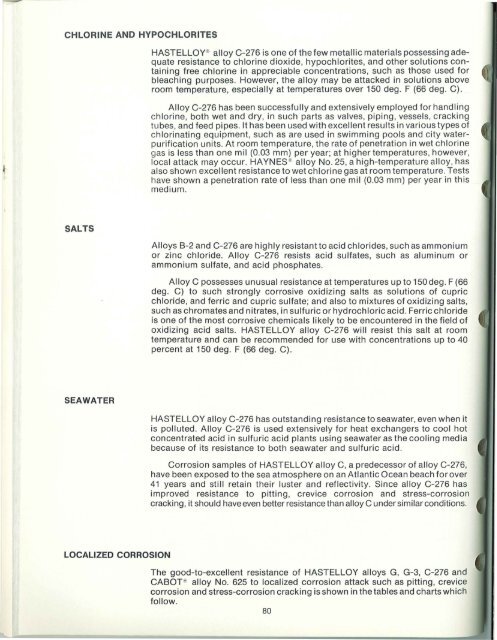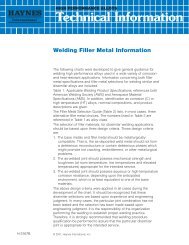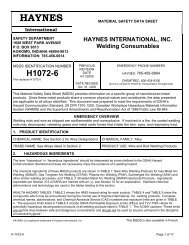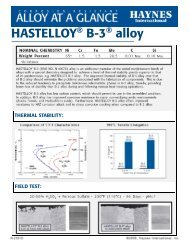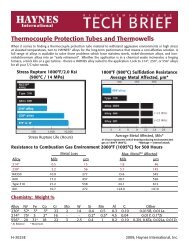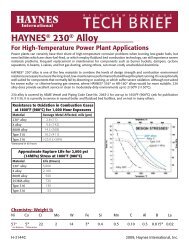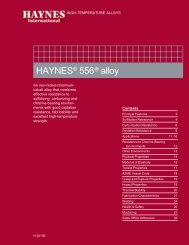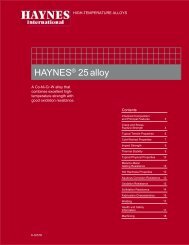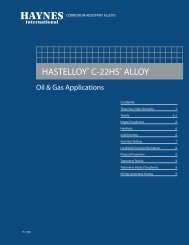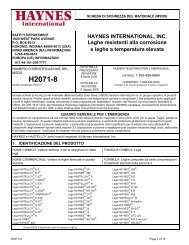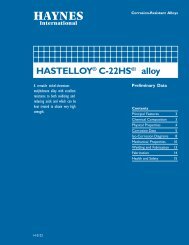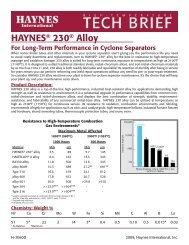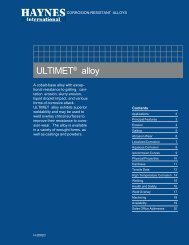CORROSION RESISTANCE OF HASTEllOY®AllOYS - Haynes ...
CORROSION RESISTANCE OF HASTEllOY®AllOYS - Haynes ...
CORROSION RESISTANCE OF HASTEllOY®AllOYS - Haynes ...
You also want an ePaper? Increase the reach of your titles
YUMPU automatically turns print PDFs into web optimized ePapers that Google loves.
CHLORINE AND HYPOCHLORITES<br />
HASTELLOY® alloy C-276 is one of the few metallic materials possessing adequate<br />
resistance to chlorine dioxide, hypochlorites, and other solutions containing<br />
free chlorine in appreciable concentrations, such as those used for<br />
bleaching purposes. However, the alloy may be attacked in solutions above<br />
room temperature, especially at temperatures over 150 deg. F (66 deg. C).<br />
~ .<br />
Alloy C-276 has been successfully and extensively employed for handling<br />
chlorine, both wet and dry, in such parts as valves, piping, vessels, cracking<br />
tubes, and feed pipes. It has been used with excellent results in various types of<br />
chlorinating equipment, such as are used in swimming pools and city waterpurification<br />
units. At room temperature, the rate of penetration in wet chlorine<br />
gas is less than one mil (0.03 mm) per year; at higher temperatures, however,<br />
local attack may occur. HAYNES® alloy No. 25, a high-temperature alloy, has<br />
also shown excellent resistance to wet chlorine gas at room temperature. Tests<br />
have shown a penetration rate of less than one mil (0.03 mm) per year in this<br />
medium.<br />
SALTS<br />
Alloys B-2 and C-276 are highly resistant to acid chlorides, such as ammonium<br />
or zinc chloride. Alloy C-276 resists acid sulfates, such as aluminum or<br />
ammonium sulfate, and acid phosphates.<br />
Alloy C possesses unusual resistance at temperatures up to 150 deg. F (66<br />
deg. C) to such strongly corrosive oxidizing salts as solutions of cupric<br />
chloride, and ferric and cupric sulfate; and also to mixtures of oxidizing salts,<br />
such as chromates and nitrates, in sulfuric or hydrochloric acid. Ferric chloride<br />
is one of the most corrosive chemicals likely to be encountered in the field of<br />
oxidizing acid salts. HASTELLOY alloy C-276 will resist this salt at room<br />
temperature and can be recommended for use with concentrations up to 40<br />
percent at 150 deg. F (66 deg. C).<br />
SEAWATER<br />
HASTELLOY alloy C-276 has outstanding resistance to seawater, even when it<br />
is polluted. Alloy C-276 is used extensively for heat exchangers to cool hot<br />
concentrated acid in sulfuric acid plants using seawater as the cooling media<br />
because of its resistance to both seawater and sulfuric acid.<br />
Corrosion samples of HASTELLOY alloy C, a predecessor of alloy C-276,<br />
have been exposed to the sea atmosphere on an Atlantic Ocean beach for over<br />
41 years and still retain their luster and reflectivity. Since alloy C-276 has<br />
improved resistance to pitting, crevice corrosion and stress-corrosion<br />
cracking, it should have even better resistance than alloy C under similar conditions.<br />
LOCALIZED <strong>CORROSION</strong><br />
The good-to-excellent resistance of HASTELLOY alloys G, G-3, C-276 and<br />
CABOT® alloy No. 625 to localized corrosion attack such as pitting, crevice<br />
corrosion and stress-corrosion cracking is shown in the tables and charts which<br />
follow.<br />
80


